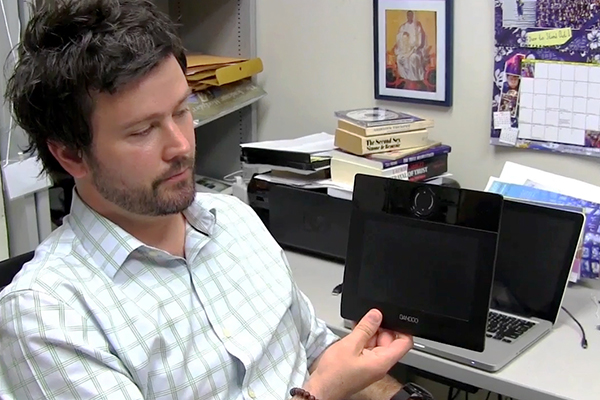Technology in the Classroom
UD faculty member teaches sociology and statistics with technology
(Editor's note: This article is part of a continuing series by University IT on innovative use of technology in campus classrooms.)
8:11 a.m., Sept. 14, 2012--Victor Perez, an assistant professor in the University of Delaware’s Department of Sociology and Criminal Justice, has found multiple ways to reach students using diverse technological approaches. Perez makes his classroom presentations highly interactive by combining a tablet with an engaging PowerPoint presentation.
Using the Wacom Bamboo tablet and its accompanying app, Perez creates illustrations of statistical formulas and distributions in class. “Bamboo Dock is something that I’ll use pretty frequently in the statistics course, and it looks literally like a journal. What’s great about this is that you can write any statistical formula, and it’s what students will see directly on the screen,” Perez said.
FYI Stories
June 6: UDid It! Picnic
2FA protects you
When paired with the statistics program, SPSS, Perez can easily display two programs at the same time, “I can compare side by side the statistical program’s values with the students’ hand written values. It’s very helpful because the students can see the underlying math that creates this output in the statistics program,” he explained.
This functionality provides ease in communicating information that writing on a board might not, such as the ability to store information if students need to review it. “You can flip to a new page, you can start again, you can flip back, and you can erase things,” Perez said.
Perez can easily slide from the Bamboo Dock app to a video, image, text, and back again to the app. “It’s extremely, extremely helpful in writing and presenting statistics and statistical information.”
Multimodal communication is something Perez believes can aid student understanding if used properly. “I think to a degree the technology is beginning to cater to what we are trying to deliver, as opposed to us catering to the technology,” he explained.
By incorporating videos of Galton board simulations and funny rap music about statistics along with descriptive images and some text, Perez finds that he can hold students’ attention and really help them understand what they are reading in the text.
PowerPoint can be useful, but Perez tries to limit the amount of bulleted text, wanting the students to focus more on the lecture rather than blocking out the speaker by jotting down text from the slides.
“I’ll use an image, for example in the introduction to sociology course, of a male and a female dressed gender opposite and I’ll ask, ‘Why does this feel strange?’ and that invites discussion. Then I can add a couple of bullets adjacent to that describing social norms,” Perez explained.
Images help liven up sociological concepts such as “McDonaldization” and “commodification.” Every year, Perez takes his honors sociology class to Ikea, which highly models these concepts, and he encourages the students to photograph one another violating the elements of these designs.
“They send the pictures to me, and then we do a brief presentation and say, ‘Here’s Johnny going against the predictable model of the arrows,’ and so on,” Perez explained.
In the future, Perez said he wants to get more use out of Google Apps, particularly with Google Docs and Google Forms. “Online peer evaluations are very useful; you can collaboratively write comments on Google Docs and get back comments on your own paper,” he said.
Also, using Google Forms is a good way to check students’ comprehension; like a pop quiz, you can glance at the answers and quickly discern if the class as a whole feels competent and is proficient. It is also good for informal feedback, responses to an issue, views on a guest speaker or what students think of the book. “I definitely want to start using those tools in both of my classes,” he added.
Watch additional videos on Perez’s use of the tablet, PowerPoint, and Ikea trip as well as his future prospects of using Google Apps.
Article by Sarah E. Meadows











